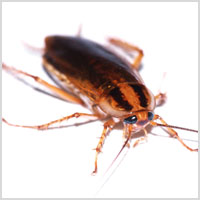German cockroach
 Common Name:German cockroach
Common Name:German cockroach
Scientific Name:Blattella Germanica
Introduction:The German cockroach doesn't actually originate from Germany but from Asia. They can be mostly found in Russia and now has spread worldwide. It has been said that they were introduced to Britain in the Crimean war. Most insects or pests are being introduced to a country or home by trading and agriculture or human traffic (transportation). It is by far the most important and usually the most common of the cockroaches, in addition to being a nuisance. German roaches mostly emerge from their harbourage, at night when lights are off and they sometimes can be spotted during daytime when in search of food and water. German roaches are very successful in establishing an ecological niche in homes or buildings, due to the large number of nymphs in one egg case (ootheca), the short time between birth and sexual maturity and ability to hide in small cracks and crevices. An infestation can develop quickly even if one is spotted in your kitchen or premises.
Recognition:Although German cockroaches have wings they do not often fly. The adult cockroach measure up to 15mm to 20mm long but the female cockroach has a broader abdomen than the male. They are light brown to tan with two dark brown parallel stripes on the pronotal shield (head and back). The nymphs have a darker abdomen and have the same dark brown stripes on their thorax as the adult. The egg case (ootheca) is yellowish-brown in colour and measures up to 6-10mm and contains about thirty eggs.
Biology: Egg>Nymph>Adult. Warm conditions are needed for breeding with temperatures about 25-30°c. On average, the female will produce about five egg cases (ootheca) (range 4 to 8), averaging 30 nymphs in each case. The female carries the egg case for about 2-4 weeks, and then releases or deposits the egg case in a sheltered area 2-7 days before hatching. The nymphs are born white and rapidly darken to medium brown and will undergo 5-7 moults taking 2-6 months (3 months average) to reach maturity. Activity periods vary with life stages, age, and condition. For instance, reproducing females are quite active whereas, gravid (ootheca-hearing) females are relatively inactive starting about the fifth day after mating and go only to food and water when necessary. Males spend most of their time in harbourages, even at night. All nymphs become immobile and stay in harbourage during the last three days while they prepare to moult. Hence, about a third of the time the cockroach nymphs will not be found exposed during an inspection. Usually, with german roaches there are about 3 to 4 generations per year. Adults live about 100 to 200 days. Established German cockroach populations are typically composed of at least mostly nymphs. Cockroaches are omnivorous and will scavenge on any form of organic materials. German cockroaches are not very active during day time, they hide in the vicinity of taps, sinks and other water sources. Due to free water source they will emerge in the dark to forage for suitable food and water.Habitat:German cockroaches are found throughout structures but prefer warm and humid places with temperature about 20-30°c. They are usually found in kitchens, bathrooms and other rooms where food and drinks are normally eaten or will spread to an entire structure if an infestation is not treated. Any cracks or crevices located near a source of food and/or water is prime harbourage.
They are mostly introduced into buildings or houses by paper and plastic packaging, used furniture and appliances e.g. grocery bags, cardboard boxes, drink cartons, refrigerators, televisions, VCR, DVD stereos microwaves, cabinets, cupboards, etc. They have been observed to migrate from building to building on warm evenings, if spaced closely together through ducting vents etc. They feed on almost anything with nutritive value including all kinds of food, and such things as soap, paste, and toothpaste.
Control :German cockroaches should be treated with insecticide, dust powder or gel baiting. Only approved insecticide should be used, in order to obtain 100% elimination. Professional exterminators in London have to ensure that every infested location is treated. Incorporating insect growth regulators (IGR) and monitoring into the services helps with long term control. To avoid a German cockroach infestation, inspect used furniture and appliances, package item before bringing them into your house or workplace.




























